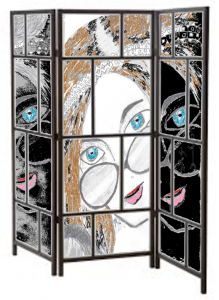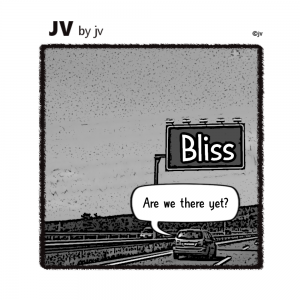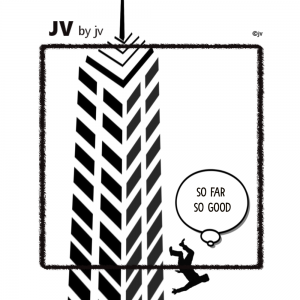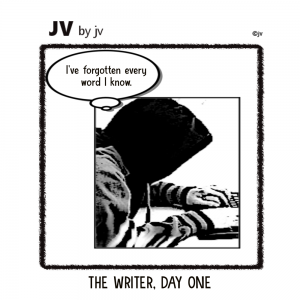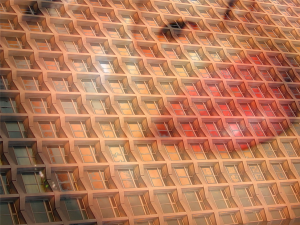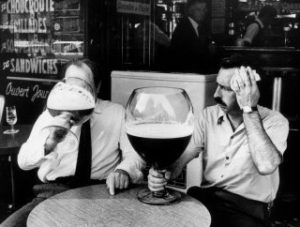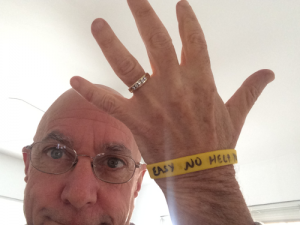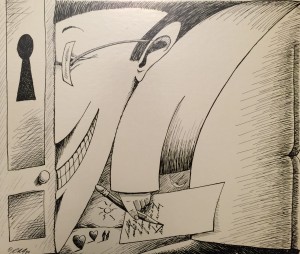Posts by John Vorhaus
Throughout my writing career, I’ve always looked for, and at, new and different storytelling tools. I pick them up, try them out, use them for a while, enthuse over them effusively… and then abandon them completely. Why do I abandon them? Because for me, storytelling tools work best when they’re new, and still have that whiff of revelation. Eventually revelation fades, and then it’s time for a new tool.
For example, there was a time in my writing life when everything I needed to know about story could be summed up thus: Story is a character’s arc of change from denial to acceptance of the theme.
It’s the tool I used to discover, develop and test stories, and it always worked a treat – right up until the time it didn’t anymore. Why did it stop working for me? Not because it ceased being true, just because it ceased being new. For me, as a writer and creative practitioner, I constantly need new ways to look at story. It’s a defect, I guess. I also get tired of my favorite flavors of ice cream, so there you go.
Lately I’ve stumbled on a couple of new tools that I’d like to share with you. Each might help you, in its way, close the gap between the story you have and the story you want to have.
The first tool isn’t even a tool, really, just an interesting set of questions:
Whose story is this?
What’s the external need?
What’s the internal need?
What’s at stake?
What’s the mistake?
What’s the learn?
What I love about this tool is how it lets me make something out of nothing just by filling in a few blanks: all the creative reward with no creative risk.
Off the top of my head, I make up this:
Whose story is this? Joe’s.
What’s the external need? To be famous.
What’s the internal need? To be happy.
What’s at stake? Joe’s emotional well-being.
What’s the mistake? Trying to gain happiness through others’ approval.
What’s the learn? That happiness comes from within.
That was easy. That took no effort at all! Suddenly, from out of nowhere, I have a story, a real story with a clear beginning, middle and end. I have a platform upon which to stand to do further development. From this new platform I can easily see or conceive that, hey, Joe is this guy who’s living an anonymous life. He thinks it should be different. He thinks he should be famous, and that fame will make him satisfied, whole and complete. So he tries to get famous, and guess what? It works! Now he’s famous. Only problem is, he’s still not happy. So he turns his back on fame, validates from within and finds true happiness (plus, probably, love) at last. That’s the story in its most basic form, and I got it – found it – not by invoking some highfalutin “magic of creativity,” but just by using a tool.
If you’re not doing anything particularly important with your next five minutes, why not pick up this tool and give it a try? Make up a story using this template. Make up two or three. Note how easily your creativity flows when it’s just a matter of answering questions and filling in […]
Read MoreFriends, I have a question for you: If I told you that I wasn’t a practicing writer anymore, would you kick me out of this community? If I told you that my entire creative axis has shifted from verbal to visual, would you assume that I no longer had anything relevant to say to writers? Or would you read my claim for the lie it is, given the fact of my having written these words here?
Maybe you’ll do the smart thing and recognize that distinctions among all forms of creative expression are just that – distinctions – and that the thing that links us all is our creative practice, no matter what form of execution that practice happens to take. With that in mind, I’d like to share a bit of what I’ve learned about art lately, and how it reflects on writing, too.
One thing I’ve learned is that a drawing starts with an idea, just as a novel does, or a poem, or a play, or a piece of music. The journey from idea to finished business traverses a landscape of versions – iterations – including sketches, studies, false starts, dead ends, botched details, blind alleys, bent perspectives, and images that just… plain… break… As with writing, music, performance, or any other creative aim, versions – iterations – are the key. With my sketches, I realize that if I’m not doing a lot of versions, I’m probably not doing it right. Those versions amount to my exploration of the idea, and just as with a novel or with anything, in the end I’ll have to know much more about the idea than it’s ever appropriate to show. Therefore, for better or worse (at this stage of the game mostly much worse), I set out to explore.
I start by setting a modest goal. Maybe I only want to draw a face with an interesting smile. Modest goals serve me because I’m not at all afraid of them. Here again my longstanding practice of writing and my emerging practice of drawing overlap. I know from way back that setting modest goals for a writing project keeps my expectations low, and with lower expectations comes better performance. That’s a handy awareness to have as I set out to do something I’ve never done before – make art – and am probably not very good at. Whether in pictures or in words, most every creative practitioner is kind of crap at the outset. The smart ones set the goal to “just be less crap,” as that’s an expectation than can easily be met, without pressure and without fear.
Read MoreA lot of people I know want to be writers but don’t have a practice of writing. Maybe they had one once and lost it. Maybe they’re just getting started in the craft. Either way, they don’t regularly carve out space and time to put words on the page, but they wish they would. It’s easy to understand why they don’t: life interferes. Maybe it’s a job. Spouse. Kids. Obligations can take many forms.
Often, obligations form a secret conspiracy with a writer’s fear to keep that writer from writing. The logic goes like this: I’ve already invested such time, energy, brain, or sweat today into [INSERT OBLIGATION HERE] that I’m totally justified in just chillin’ like McMillan and not feeding my need to write.
Justified, yes. Happy, no. Why? Because that need needs to be fed and it won’t shut up when it’s hungry. This puts many a writer in a tough, tough spot: We want to write but we fear to write. If you’re in this bind, my heart goes out to you, and I really want to help you over the hump and into, or back into, your active practice of writing.
Often all it takes is a catalyst, a little exercise you can do that will transition you easily and painlessly from not-writing to writing. Fortunately, I have just such a tasty template right here. Simply follow these steps:
1/ Recognize the conspiracy between outer events and the inner fear to write. Recognize that we often use the excuse of [OBLIGATION] and many, many other excuses to serve our fear of writing and impede our practice. Nothing can be done about that. Fear is part of the package, a standard accessory in most writers’ lives.
2/ Acknowledge this fear and move on. Recognize and accept that you’re in a “gentle conspiracy of non-productivity.” Now get over it. That’s yesterday’s news. Today’s news is all about moving on.
3/ Set up a writing day and time. Put it in your calendar. This isn’t a lifetime commitment, just a one-off. And here’s good news: For this exercise, even a half-hour window will do.
4/ Set an appropriate goal for that time. You only have half an hour; you won’t be writing War and Peace. What you will be doing is experiencing or re-experiencing yourself as a writer. Without value judgments. Without any investment in outcome at all. Your appropriate goal is just this: to feel how it feels to write.
5/ Set a doable task, something you can get through in half an hour. One I like is the exploration of an explosive moment of change.
6/ Now here comes the (easy) writing part. (Easy because the goal and target are so clear.) First thing, create a new character. Any one will do, so make any old choice. You might call him or her Sam.
7/ Assign your character an emotional state. Sam is sad.
8/ Now just ask yourself this simple question: What could change your character’s emotional state? It’s Sam’s surprise birthday!
9/ Next, note the new emotional state. Sam is happy.
10/ And that’s a moment of explosive change: a transformation from one emotional state to another, facilitated by a new piece of information. Write one page about that.
Well, there it […]
Read MoreIf you were following WriterUnboxed back in 2013, you may have read a version of the column you’re about to read. (If you can remember having read it, you’re better person than I am; I can barely remember what I had for breakfast.) I was reminded of it recently, and inspired to share it again, while helping a protégé understand that the journey of a writer – a real writer – is the journey toward emotional truth.
Writers often find themselves confronted by the question, “What is emotional truth?” and the further question, “How do I put it on the page?” As someone who has taught and trained writers all over the world – and of course struggled with these questions myself – I find that writers go through predictable stages in their quest to convey authentic emotional meaning in their work.
At first, many writers have no idea that such a thing as emotional truth even exists. They are focused solely on making the logistics hold up, making the jokes funny, or advancing the action from event to event. At this stage, there is little or no thought to a work’s deeper meaning or deeper human understanding. I call this the “run and jump” phase of our writing careers, when all we can really see, and all we can adequately convey, are the mechanical aspects of the work. The mysteries of the human heart yet elude us.
As we mature as writers, we become aware that there’s such a thing as emotional truth, but we don’t quite known how to get this information from brain to page. Our first efforts in that direction often seem awkward and stilted. We might try to write, “I love you,” only to recoil in self-conscious horror at the awful, inauthentic, clichéd obviousness of those words. We hate ourselves for writing so artlessly about subjects of such importance. We haven’t yet made – at least to our satisfaction – the connection between simple human truths and their meaningful, effective, evocative presentation on the page.
But we get better. We do. We grow and develop, deepen our awareness of the truths we wish to convey, and also acquire the means to do so. We discover tools like text and subtext, and bring our writing to the point where one character may ask another, “How about some microwave popcorn?” and have it understood to mean, “I yearn for you to the bottom of my soul.” We become writers with sufficient insight to detect emotional truth and sufficient toolcraft to capture and preserve it in words. So we’re home and dry, right?
Maybe not. Maybe we’re still afraid.
Read MoreSo it’s back-to-school time and right now my heart’s going out, as it does every year, to my youthful compatriots in creativity, earnest young strivers desperate to know that the writer’s path is one they can fruitfully walk. It’s so hard when you’re that age (okay, any age) and you yearn for a life of creative engagement but all these obstacles stand in your way. Can you make it pay? Can you meet others’ expectations (or silence their objections)? Can you stand before the world saying, “This is my voice! It means something to me and I want it to mean something to you!”? (Can you punctuate that last sentence correctly, ‘cause I’m not entirely sure that I have.)
For young people in thrall to such questions it’s a particularly knotty problem. Think of the burden they bear: completely creatively inflamed and pretty completely creatively disempowered. This is the lot of any high school or college student who is being channeled away from (or is self-channeling away from) the writer’s life or any other life of creative pursuit. That’s not what they want. They know it’s not what they want. They just don’t know if what they want is a realistic or viable option.
Let’s say that the writer’s life is a roll of the dice. I don’t personally think that it is; I think that choosing a life of the mind, any life of the mind, is about as sure a bet as you can make in life, in terms of happiness, fullfilment and getting down to the isness of it all. But that’s not how it looks to an earnest young writer. It looks like a big gamble, and what if it doesn’t pay off? That future has disastrophe written all over it.
How can we set that young person free?
There stands a writer, desperate to walk the writer’s path, and desperate to know that the path will be fruitful… successful. What can we say to that writer? Here’s what I’d say.
1/ The path is the path. You’ll either walk it or you won’t. But the decision to walk it – the simple act of saying, “I’m a writer” – opens every meaningful door. If you’re wondering whether you can be a writer, the words “I am a writer” are an epic expression of self-fulfilling prophecy. Say you are and you are.
2/ Get support on the path. Creative people ally themselves with creative people. Once you’re a writer you’re in community, and in community there is strength. So go ahead and self-define as a writer. Once you do that, you can go where the writers go, and discover that they’re just as insecure and crazy and hell-bent as you are. As a writer you’ll need that, so get it.
Read MoreAs some of you know, I recently had rotator cuff surgery, which put my writing practice temporarily on the shelf. This was a big problem for me, because I’m not the sort of person who can sit around doing nothing for too long (“too long” being defined as the time it took me to watch every damn episode of Breaking Bad). I needed some form of creative expression, something I could do with one hand – my off hand – until my shoulder had sufficiently healed.
I turned to art.
Well, not art exactly – graphic image manipulation, through the good offices of a wonderful, free program called GIMP (www.gimp.org). I had tinkered and toyed with the program before – squeezed a couple of book covers out of it – but I’d never really set out to plumb the depths of its potential. More to the point, I’d never set out to be an artist before.
I was scared spitless.
After forty years of self-defining as a writer, I was suddenly somehow trying to self-define as, well, something else. I knew I couldn’t call myself an artist; I hadn’t in any way earned that title. But if I didn’t call myself something – something at least vaguely aspirational – how would I or could I ever fight through the thicket of learning and growing – and rank insecurity – that lay between me and genuine artistic expression?
How, in other words, could I fight my fear of failure?
Well, the first thing I did was craft an artist’s manifesto. (When I told an artist friend of mine that I had done this, he just laughed and said, “That’s such a writer thing to do.”) Here’s it is:
1/ I will create images I believe in.
2/ I will decide which images I believe in.
3/ I will stand behind the images I create.
Here’s how having a manifesto immediately helped: It let me sidestep the judgment of others, and my attendant fear of that judgment. By putting responsibility for deciding what worked and what didn’t squarely in my own hands, I emotionally supported my earliest efforts with a certain bravura bravado. I knew that failure would be a big feature of this particular learning curve, but also that there would be instances of “not failure” – the creation of images that pleased me or made me laugh – and that it was up to me to recognize those instances and take satisfaction in those early, halting successes.
Were one to substitute the word “sentences” or “stories” for “images” in that manifesto, it would be a pretty good one for writers too, I think.
Read MoreMy nephew turned twenty-one last night, so I did the avuncular thing and took him out for his first legal beer. The talk turned, over beers, as talk will turn over beers, to “the meaning of life and the isness of it all.” He asked me why I write, and, in true Socratic fashion I tossed the question back to him. “Why do you think I write?” I asked, and he told me the two reasons that immediately sprang to mind: money and ego.
We parsed these possibilities, and soon dismissed them as dead ends. If I were in it for the money, we reasoned, there were many other careers I could choose that would draw a more reliable and ready earn. The writer’s path, on the face of it, is just a lousy longshot choice if all you want is walking green.
Ego, then? Ego? The soul-satisfying sense of everyone looking at me in admiration and deep awe? That’s a great goal if you’re [insert famous writer’s name here.] However, if you’re a low- to mid-list author like me, the search for ego gratification through writing is, like the search for fat paychecks, kind of a dry well. More often than not, it’s going to go the other way. The world will largely ignore, or resoundingly reject, my written words, and then the only thing my ego gets is the grey, dismaying sense of, “Ouch, my feelings.” No fun. And no path that a sensible person might choose.
At this point, I think, my nephew began to become dismayed – sad for his “silly Uncle John,” who has never successfully masqueraded as a sensible person but could at least be counted on to make choices in his own self-interest. If the money wasn’t there, and the ego strokes weren’t there, what could possibly be worth banging my head against the page for day after week after month after year? Was my career, in the end, not the very definition of insanity – doing the same thing over and over again, expecting different results?
That’s when I hit him with the third thing – the one thing that’s kept me coming back to words on the page from the very start to these very words here.
Read MoreAuthor’s note: I’m currently rehabbing from rotator cuff surgery (forty years of ultimate frisbee will, in fact, take its toll) and my time at the keyboard is constrained by my doctor’s – and my shoulder’s – orders. We could pause to dwell on the remarkable fact that the word “constrain” means both to require and repress, but that would be a waste of the few keystrokes I’m presently allowed. We could also note that “presently” means both now and later; instead let’s dip into the archives for this month’s missive, ripped from the pages of my book Creativity Rules…
The Noble Eightfold Path, that bedrock of Buddhist thought, is a simple, sublime prescription for anyone striving to live an effective life. It seems like it should work for writers, too.
Right Knowledge: Know what you’re up to. To the extent that you know yourself, write yourself. To the extent that you want to improve your writing, improve your self-knowledge. But world-knowledge counts too, especially if it’s knowledge that others don’t have. If you’re an avid hang glider, your hang gliding experience gives you unusual insights, a specialized vocabulary, a built-in market for your work, and an interesting story to tell. If you know a great deal about banana slugs, that’s kind of gross, but it gives you an edge over writers who know less in the highly competitive field of banana-slug scribery.
Right Aspiration: Set appropriate goals. There will always be a gap between the writer we are and the writer we want to be. Worse, in the sense that no matter what writing stunt we pull off, we always want to do more, we’re kind of always moving the goalposts on ourselves. Thus, there’s really no such thing as “done” for a writer; there’s only closing the gap. So embrace it. Feel yourself grow as a writer. Give yourself the satisfaction of hitting harder targets. Seek to be a better writer today than you were yesterday. That’s an appropriate goal, and one you can always achieve.
Right Speech: Say what you mean – effectively. Writing is code. When we write, we encode our thoughts as words on the page. When readers read, they decode our words back into thought. In this sense, writing and reading resemble the kids’ game of telephone, where a whispered phrase starts out as, “Hard choices confront diligent writers” and ends up as, “Head cheeses convert disco fever.” Remember that your code has power – the power to persuade. And the more you improve as a writer, the greater this power becomes. So have a care with your code, and make your message count.
Read MoreI pick things up off the ground. I’ve done it since I was a kid and I don’t apologize for it; over the years I’ve snarfed up all sorts of neat stuff: cash, cameras, trinkets, tickets, ephemera, found art and life-changing objets d’étrange.
Yesterday I found a yellow wrist band, the kind you wear for causes or adorn with mottos. This one read, “Live Wisely and Always Choose the Right!” Well, I’m constantly on the lookout for mystic messages from beyond, so I paused to contemplate this one. The right what? I wondered. Path? Project? Freeway exit? Or maybe it just meant “right” in an objective sense: When faced with two choices, make the correct one. Okay, well, that’s good advice and self-evidently worthy of a wristband, but in terms of mystic messages it didn’t much float my boat.
My day continued.
I met a friend for coffee and he recounted an encounter with a masseuse who had heavy hands and English as a second language. When he cried, “Easy, easy!” she barked, “Easy no help you!” I heard that, and I thought, Easy no help you? Hey, that’s the motto for me! I whipped out my Sharpie and inked it onto my wrist band. Turns out that material is pretty ink-proof, and I had to reapply my motto every fifteen minutes or so. Well, so, easy no help you, right? So let’s talk about what that means for us writerly types.
We start by noting that writers often exist in a have-more, need-more condition, where meeting our every (or any) writing goal perversely but reliably inspires us to engage bigger, harder goals – for instance how writing a kick-ass short story can whet one’s appetite to tackle a novel next. Some writers live with this itchy discontent and recognize that never quite being satisfied is just part of the hand they’ve been dealt. Others are happy to get good at one thing and then keep cranking it out, and if it brings them success along their chosen path, then I say, “Mazel tov.” Many writers, especially those who haven’t found their first success, don’t know which path to follow. Which choice will bring us success? We’d be happy to “Always Choose the Right!” if only we knew what the right was. Here’s where easy no help you can help.
Easy no help you. You build muscles by climbing. If it’s in your head that the writer’s road is always up, then the things you might write, or might think about writing, are the ones that will challenge you most but also help you most. Trouble is, doing hard things is, well, hard. And if something’s hard, we’re unlikely to be very good at it to start. Staring down the barrel of failure is, for many, an uncomfortable view. For some it’s impossible: The thought of writing a “failure” is so psychically painful that they end up just not writing at all.
Read MoreHere’s what I do for weird fun and lexical exercise: I take lists of words I don’t know and weave them into stories, defining the words in context as I go. I’m flexing two creative muscles here, one that develops story and one that exploits language. I use this challenge and ones like it to shed clarity on my creative process, which, at its heart, is a strategy of setting a goal and then acting on it. In everything I write, I set goals – I frame the exercise – then I act, and that’s how I get things done. Pretty simple. It’s effective. It’s made more effective through exercise, and that’s why I bother to spend the time turning this – after-wise, babblement, cycopede, daggle-tail – into this:
“After-wise, when I had a chance to reflect on it, I realized it was all babblement from the start, her way to confuse and betray me. In all the cycopede of human knowledge there is no word vile enough to demean that daggle-tail minx.”
And that’s why I invite you to, too. I’ll give you the words, and you see what fun you can have.
(I’m sure you can think of a thousand reasons not to try this game, everything from it’s dumb to I might fail. For now let’s say that none of those apply. Just have some fun.)
Here’s our list.
Read MoreSo I’m trying to bootstrap my writing game to the next level by investing time and hard work in research. Now, those who know me know that “I hate research like a cat hates baths.” But just now I made an amazing personal breakthrough and since I love process as much as I hate research, I wanted to share it with you at once.
There I was, reading source material and taking notes. I had my .pdf research file and my “store notes here” file open side by side on my big computer screen, and when I read something useful on the left side, I’d write it down on the right. This wasn’t going okay. I was bored. The act of doing research didn’t engage me at all. It wasn’t telling me what I really wanted to know, and it seemed to be taking way too long. Worse – worst – I was impatient to write; I’m always impatient to write. I never feel particularly good when I’m not writing, and even laying the necessary pipe of research doesn’t quell the itchy feeling that “I’m falling behind in my existence.” Yuck, right? Yuck.
Then I had a thought – a revelation, really – and it stemmed from my bedrock belief that “all assumptions should be questioned all the time.” At that moment I was operating under two assumptions. One was that I hate research and the other was that I was doing research the only way research could be or should be done. Determined to challenge those assumptions, I asked myself what my research was really meant to do. Add data, right? Give me enough information to “solve the problem of the story.” But there were other storytelling problems to be solved as well: problems of event, voice, detail, characterization, dialogue and so on. I was using research to do this one narrow thing – add data – but I suddenly realized that it could do much more.
So here’s what I decided to try: Instead of just mechanically recording relevant information, why not try interpreting it? By these means I could interestingly multitask, not just completing the “odium” of research, but also bench-testing my characters’ voice, vocabulary and point of view, plus the many ways I might choose to convey this world on the page. To put things in an even neater little nutshell: Instead of just gathering information, I decided to build a relationship with my research – a dynamic relationship that didn’t just store future building blocks of story but put them into story right frugging now!
Read MoreAs the international television consultant I sometimes am, I sometimes find myself working with people coming into TV script writing from other forms of writing, for the simple reason that in many parts of the world (well, my world) trained and experienced TV writers are thin on the ground. For those coming into TV writing from backgrounds in solo writing, it can be difficult to adjust to the collaborative creative process that writing for television demands. Such writers often have the expectation that their feelings will be taken into consideration – that they’ll be treated gently. They quickly learn that in the hothouse environment of a TV writers’ room, your ego is your own affair, and any time you go, “Ouch, my feelings,” that’s pretty much a problem you get to have all alone.
When I’m the bearer of this bad news, I try to break it gently – but, weirdly, not too gently. I don’t want to hurt anyone’s feelings, sure, but in the writers’ rooms I run, I don’t really want people’s feelings to be an issue at all. I want to get into productive collaboration as quickly as possible. So I ask my writers to join me in adopting a certain useful fiction (a useful fiction is something that everyone knows to be untrue, but agrees to anyway, for the sake of a common good). The useful fiction I’m promoting here is, “Inside this room, feelings don’t matter.” We all know it’s not true. We all know that our egos will make their presence known. But if we collectively commit to serving the work and not the ego, then we can go about the business of giving one another hard notes – often terribly brutal notes – without anyone wanting to open the nearest window and hurl themselves out.
Let’s say I’m giving story notes to a writer who’s never had anyone comment meaningfully on her work before. This is a very common situation in my line of work, and you would think I’d handle that writer with kid gloves. Yet kid gloves are the last thing I want. If I try to couch my notes in protective language, my message might not get through. Worse, my efforts to do so just reinforce the idea that protecting each other’s feelings is, or should be, our priority, which leads to more pulled punches and more lost efficiency. So I just say, “The notes are the notes. I know you’ll have an emotional reaction to them, but remember that here in this room we pretend that those feelings don’t matter. This clears out the space between us and lets us focus, together, on closing the gap between where the work is and where it needs to be.”
Read MoreThe first two novels I wrote appeared in serial form in a biweekly magazine, back around the turn of the century, when I basically bet that I could stay one step ahead of a pretty relentless deadline and/or still be churning out words when the fledgling magazine went belly up. I’ve always had a huge fondness for those novels, not so much for the content, but for the exhilaration of meeting that deadline, and for the audacity of thinking I could do so.
“Here are these training wheels, bub – now go hit the speedway.”
One of the novels I later published under the Bafflegab Books imprint and it continues to sell steady ones of copies to this day. The other remained an unexploited resource which, recently finding myself temporarily between projects, I took into my head to resurrect, edit, and fling unto the world. That was the plan. Let me tell you why it didn’t work out.
Read MoreTake a look at the picture accompanying this column. If you can’t read the text on the hat, here’s what it says:
I work…
I cniok…
my happiness…
I found this beautiful oddity on a recent trip to Europe, at a roadside rest stop where such head-scratching or unintentionally hilarious assaults on the English language can commonly be found on hats, jackets or shirts. Freak that I am, I kind of collect them, or anyway take pictures (though okay, I admit I did buy the hat). On this same trip, I also saw “Genuine Gear Vanguard Original Series All American Ride,” which I can kind of understand. But cniok? What the cniok is that?
I gather from context that cniok might be a verb, and I can reasonably guess that it’s somehow related to work. But how? Maybe it’s intended as a counterpoint, as in, “When not otherwise occupied by gainful employment I enjoy recreational cnioking and cniok-related activities.” Then again, it could be a reference to the higher mind, in the sense that one must first work and then cniok, or perhaps work hard or harder at cnioking, in order to attain one’s happiness. Can cniok be the road to nirvana? Your guess is as good as mine.
Read More

